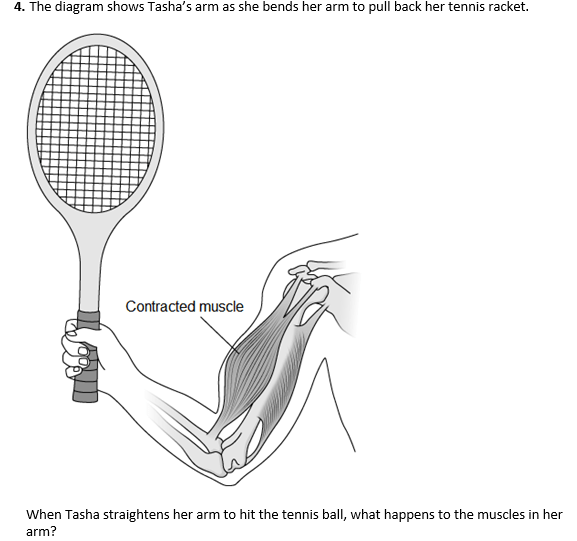What is the function of the heart?
The heart pumps blood.
What are two organs in your body that work in together to help you move?
They are your skeleton and your muscles.
What is the command center of the nervous system?
brain
What does the stomach do?
The stomach breaks down food into nutrients that the body uses.
As the blood vessels spread further out into the body and get closer to the body’s cells, do the blood vessels get smaller, larger, or stay the same size?
The blood vessels get smaller and smaller.
9.
Sasha created this table showing information about the muscular system.
Muscular System
Muscle types
- ribbed
- smooth
- cardiac
- skeletal
Which word should be removed from her list?
ribbed
What are the five sense organs?
The five sense organs are the eyes, ears, nose, skin, and tongue.
kidneys
What do the lungs exhale?
Carbon dioxide, a waste gas, moves from your blood to the lungs and is then exhaled. The lungs eliminate 70% of waste through breathing.

The top muscle (bicep) relaxes, and the lower muscle (tricep) contracts.
What makes up the central nervous system?
The brain and the spinal cord make up the central nervous system.
What two organs send digestive chemicals to the small intestine?
The two organs that send digestive enzymes to the small intestine are the liver and pancreas.
How do lungs inhale?
When you breathe in, or inhale, your diaphragm contracts and moves downward. This increases the space in your chest cavity, and your lungs expand and fill with air.
How many bones and muscles does the human body have?
The human body has a little over 200 bones and 600 muscles.
What are some of the functions of the brain that control the body?
The brain interprets information from the senses; it sends messages telling the body how to respond.
How are the functions of the small intestine and large intestine different?
The small intestines absorb nutrients from food and the large intestines absorb water and moves waste out of the body.
How long is the circulatory system?
The circulatory system is about 100,000 kilometers (km) long. Your blood vessels could circle the earth.
List three functions of your skeletal system.
Bones give the body shape, provide a structure for muscles to attach to, protect vital organs, and produces blood cells.
How does the nose also help with the sense of taste?
Some of the chemicals picked up by our nose when we are eating are interpreted by the brain to be flavors.
skin